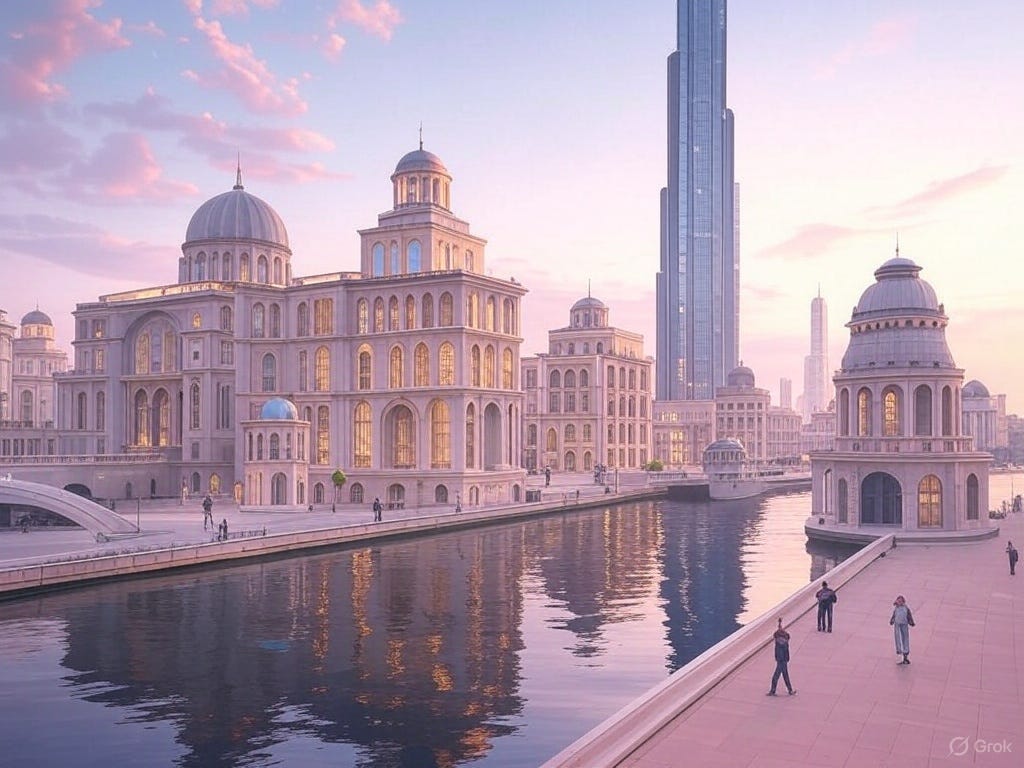
Architecture is one of those things we don’t think about until we’re either inside a really beautiful building… or trapped in an airport designed by someone with a grudge against humanity. But have you ever stopped to consider that architects are basically time-traveling wizards? They summon the ghosts of history, shape the present, and predict the future — all while wearing really nice glasses.
A Brief History of “Let’s Put a Roof Over This”
Long before we had the starchitects of today — those designers who turn every building into an art installation and every sidewalk into a photoshoot backdrop — architecture had a very simple goal: keep things from falling on people’s heads.
The Early Days: Mud, Stones, and Ambition
The first architects were probably just very bossy cave dwellers. “No, Thog, we can’t put fire pit under wooden roof. We all die.” From there, humans got creative. The Egyptians built pyramids (great for dead people, slightly inconvenient for open floor plans). The Greeks figured out how to make temples look important (columns, always more columns). The Romans, bless their engineering hearts, gave us concrete and the aqueducts — because nothing says “civilization” like indoor plumbing.
The Medieval Period: Castles, Cathedrals, and Cozy Dungeons
Fast forward to medieval Europe, where architecture was basically a contest of “who can build the most intimidating stone fortress.” Castles were the original gated communities, and cathedrals were the architectural equivalent of a humble brag — “Look how high we can make this ceiling. Bet your church doesn’t have flying buttresses.”
The Renaissance: “What If Buildings Had More Drama?”
Then came the Renaissance, when architects said, “What if we took all this gothic seriousness and added a little spice?” Enter domes, mathematical proportions, and an obsession with symmetry that would make even the most dedicated perfectionist jealous.
Modernism: “Walls? Who Needs ‘Em?”
Jump ahead to the 20th century, and architects basically decided to remove as many walls as possible. The goal? Make everything sleek, functional, and devoid of unnecessary ornamentation. The Bauhaus movement declared that form should follow function, while Le Corbusier tried to convince us that houses were just “machines for living.” (Some of us would still like a little personality in our machines, but okay.)
Postmodernism: “Actually, We Want the Funk Back”
Modernism eventually got so serious that architects rebelled. Cue postmodernism — where buildings got weird again. Suddenly, structures had playful shapes, neon colors, and facades that looked like someone had assembled them with leftover parts from a LEGO set.
Contemporary Architecture: Glass, Greenery, and Giant Screens
Today, architecture is all about sustainability, smart technology, and making everything out of glass. We’ve also somehow landed in an era where buildings try to be both futuristic and eco-friendly — hence why every skyscraper now has a vertical garden or a rooftop solar farm.
The Architect’s Toolbox: More Than Just Fancy Pens
If you ever meet an architect, know this: they have opinions about everything. They will judge a door handle. They will have a favorite kind of concrete. They will, at some point, mention Frank Lloyd Wright.
But what makes an architect’s job really magical is that they turn ideas into reality. With tools like computer-aided design (CAD), 3D printing, and augmented reality, they can see the future before a single brick is laid. And yet, despite all these high-tech advancements, some of the best architectural ideas still start as a rough napkin sketch.
The Secret to Appreciating Architecture
Look around. Seriously. Take a moment and observe the buildings you pass every day. That apartment complex? Someone agonized over that window placement. That random public bench? An urban designer debated its exact location. Even that weird, vaguely futuristic bus stop — yep, someone pitched that in a meeting with a straight face.
Architecture shapes how we live, move, and experience the world. It’s a mix of science, art, and just a little bit of sorcery. And if you ever find yourself walking through a breathtaking cathedral, a stunning skyscraper, or even just a really well-designed coffee shop — take a second to thank the architect who made it possible. (Preferably with a very sincere nod of appreciation. Or an espresso. Architects love espresso.)
So, What’s Your Favorite Building?
Drop a comment below with your favorite piece of architecture — whether it’s a historic wonder, a modern masterpiece, or just your childhood treehouse. And don’t forget to follow me for more posts like this — because buildings may last forever, but algorithms need constant feeding.
Art Prompt:
A luminous cityscape at twilight, bursting with soft hues of lavender, rose, and gold. The skyline features a dreamlike blend of classical and futuristic architecture, where domes and ornate arches merge seamlessly with sleek glass towers. The sky is alive with warm brushstrokes, reminiscent of Impressionist masters, while reflections dance upon a gently rippling canal. The scene exudes both nostalgia and optimism, capturing the ethereal beauty of a city suspended between past and future.